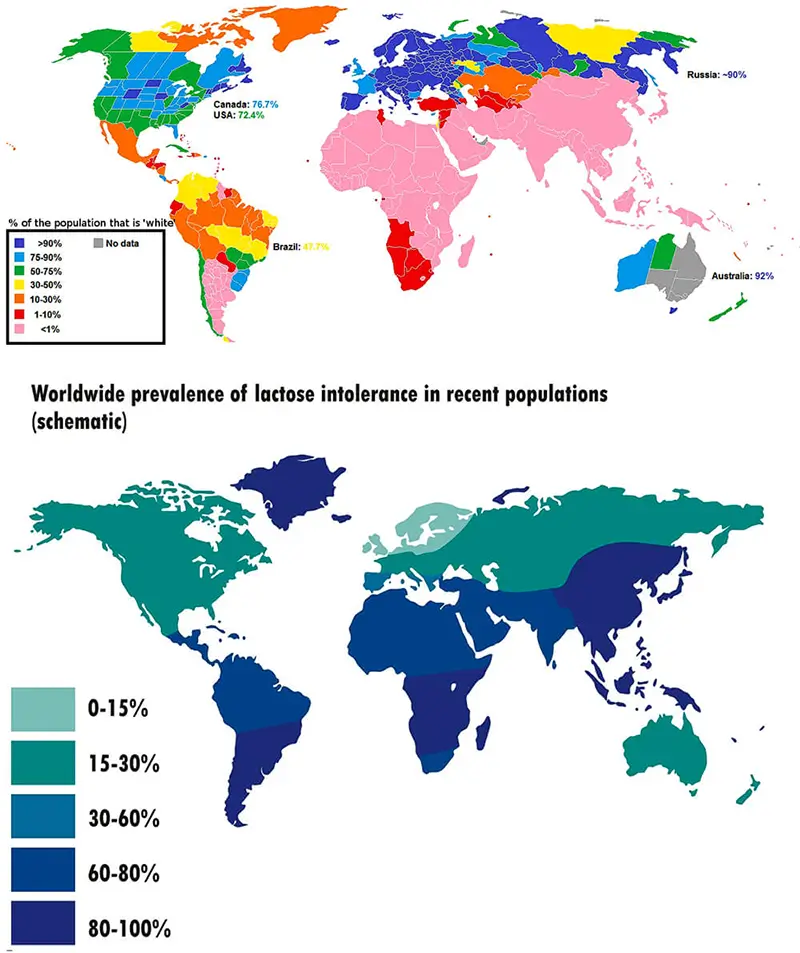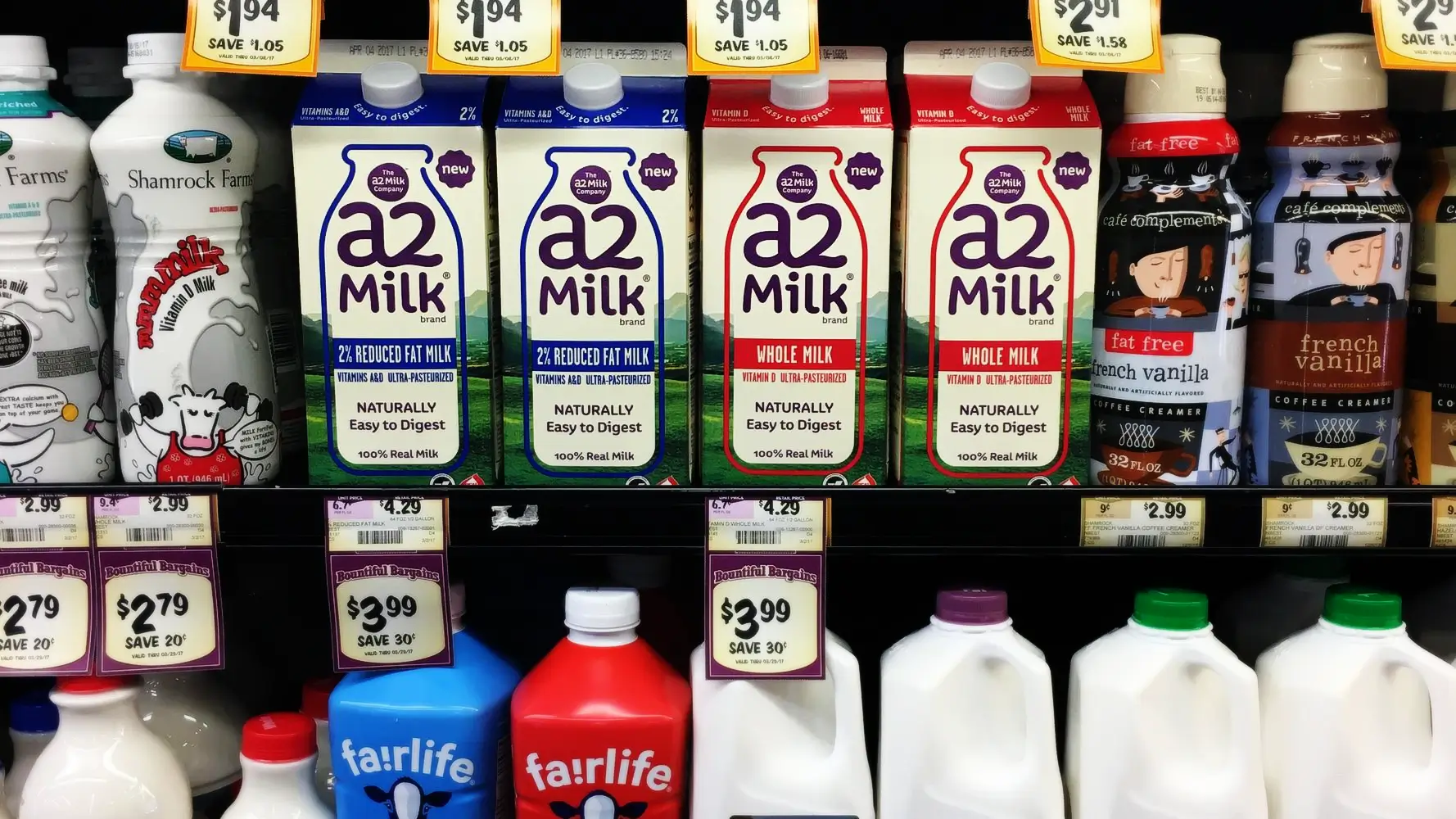Lactose intolerance- 65% chance you have it
People of European descent can drink milk and the rest of the globe has lactose intolerance. There are however substances in milk that none of us can tolerate.
Milos Pokimica
Written By: Milos Pokimica
Medically Reviewed by: Dr. Xiùying Wáng, M.D.
Updated May 7, 2023People of European descent can drink milk and the rest of the globe has lactose intolerance. Black Africans are 98 percent lactose intolerant and numbers for lactose intolerance in Asia are similar (Ugidos-Rodríguez et al.)[1].
Scientific research confirmed in different ancient European genome studies that the hunter-gatherers in Europe could not digest lactose in milk 8000 years ago. The first Europeans who domesticated wild animals were also unable to consume milk. The settlers who came from the Near East about 7800 years ago also had lactose intolerance. The Yamnaya pastoralists who came to Europe from the eastern steppes around 4800 years ago also had lactose intolerance.
It was not until about 2300 BC about 4300 years ago, in the early Bronze Age, that lactose tolerance swept through Europe (Gamba et al.)[2]. When we look at today’s world most of the population still can’t digest milk. If lactose-intolerant individuals consume lactose-containing products, they may experience bloating, nausea, abdominal pain, flatulence, and diarrhea.
Lactose is split down into a regular usable sugar by a specific enzyme called lactase created by cells in the wall lining of the small intestine (Storhaug et al.)[3]. Production of lactase is turned off in mammals in adulthood because mammals breastfeed only in the first periods after birth. Later in life in average conditions, it is not necessary to have this enzyme because no mammal will ever breastfeed again, except humans. Grown mammalian species do not breastfeed, and the organism is adapted to turn enzymes off to save energy. By domesticating wild animals and milking them, early farmers changed the condition of their habitat, and in time organisms adapted.
Today only descendants of European farmers can still digest milk. Black Africans cannot. Asians cannot. The statistic for lactose intolerance is like this. Approximately 65 percent of the entire human population has a reduced ability to digest lactose after infancy. In comparison, 5 percent of people of Northern European descent are lactose intolerant.
There are, however, a lot of substances in milk that we cannot tolerate. Even if we are from dairy queen countries we still can’t cope very well with things like cholesterol, a form of Lacto morphine called casomorphin, and estradiol (dairy consumption accounts for 60 to 80 percent of all estrogen consumed in the typical American diet). Opiates from the mother’s milk produce a sedative effect on the infant. That sedative effect is responsible for a good measure of the mother-infant bond. Milk has a drug-like effect on the baby (or other mammalian cubs), and it guarantees that the baby will bond with the mom and proceed to the nurse and get the nutrients. It is an evolutionarily beneficial adaptation. Similar to heroin or codeine, casomorphins slow intestinal movements and have an antidiarrheal effect. The opiate effect is the reason why cheese can be constipating just as opiate painkillers are.
Lactase is an enzyme that allows the organism to digest milk sugar, and that sugar is lactose. Danes are only 2% lactose intolerant.
All mammals after rejection from sucking are lactase deficient. They do not have contact with the milk later in life. The reactions of any organism that does not need to use the sugar lactose in adulthood are to deactivate the enzyme lactase so that the enzyme lactase is deactivated at the level of the genes. Except for the European farmers, which forced their bodies for thousands of years to consume it.
Thus, Danes today are only 2% non-tolerant, Finland 18%, Indians 50%, Israeli Jews 58%, African American 70%, Ashkenazi Jews 78%, Arabs 78%, Taiwanese 85%, Greek Cypriots 85%, Japanese 85%, Thailand 90%, Filipino 90%, Black African over 90% (Storhaug et al.)[3]. WHO has put that number up, saying that it is around 95% to 100%, for Indians 90 to 100, for Asians 90 to 95, for Mediterranean 60 to 75 and North American 10 to 15 and Europe 5 to 10 percent.
The real problem is that even if we are lactose tolerant lactose is metabolized in an unnatural way and is not meant to be consumed for an extended period of time. We have the enzyme lactase that breaks sugar lactose on dextrose and galactose. Half is glucose and the other half is galactose.
However, galactose cannot be used until it is digested in glucose. Cells only use glucose as fuel. There is an enzyme called beta-galactosidase that changes galactose into the glucose that we need. However, since no animal needs this enzyme after rejection, this enzyme is deactivated forever. Everyone, every human on the planet Earth if it is a grown individual has galactosidase deficiency. All of you who are reading this now and I have a deficiency of beta-galactosidase. This means that if you consume sugar from milk meaning lactose if you are lactose tolerant you can use it, you have lactase. Lactase metabolizes lactose and you will get glucose and besides it galactose. Glucose will be used normally. And with galactose, what are we going to do? We cannot use it so where does galactose go?
Some of it gets ejected outside through the skin. Some end up in the eyes and are stored in the cornea. Elderly cataracts come from galactose. Adults who consume large amounts of milk, and have high lactase activity, often suffer from galactose accumulation of galactitol in the eye lobe and have a high likelihood of elderly cataracts (Arola et al.)[4].
Not only that but it is also stored in the body in other places as well. Women are accumulating around the ovaries, and it is associated with cancer of the ovaries and infertility. One in four couples goes to infertility treatments in European countries. In African countries, where they do not use milk, they have no problems with infertility. It is unknown as a disease. In Daniel W. Cramer Harvard Medical School study (Mustafa et al.)[5] a link between the consumption of galactose and the increased risk of ovarian cancer was observed. Lactose-intolerant women are likely to consume less lactose. They concluded that: “This finding suggests that decreased lactose intake early in life may reduce ovarian cancer risk although further studies are needed to confirm this finding.” For Thai women, for example, who do not consume milk, there is no infertility at the level of statistical significance. In Thailand where 98% of adults are lactose intolerant, the average fertility among women aged 35-39 years was only 26% lower than the maximum rate for ages 25-29 years. In Australia and the UK, where lactose intolerance affects only 5% of adult people the fertility rates for 35-39 years old are full 82% below the maximum rate for 25-29 years.
Besides the risks of milk consumption in lactose-tolerant individuals can drink milk, what will happen when an individual that is not tolerant of lactose drinks milk? Sugar from milk will be undigested. It will cause lactose to be broken down by bacteria in the intestines. Bacteria will start to multiply, this increases osmotic pressure, fluid flows into the intestines, and the individual gets diarrhea.
After World War 2, the U.S. had a big stockpile of powdered milk that they had to dispose of somehow. Instead, they decided that because there is a “protein gap” they send that powdered milk to Africa as humanitarian aid. Many already malnourished children and babies got diarrhea from it. African countries that got milk powder sent as humanitarian aid experienced an increase in mortality, especially in small children who were already at the level of severe malnutrition.
References:
Passages selected from a book: Pokimica, Milos. Go Vegan? Review of Science Part 1. Kindle ed., Amazon, 2018.
- Ugidos-Rodríguez, Santiago, et al. “Lactose Malabsorption and Intolerance: A Review.” Food & Function, vol. 9, no. 8, Royal Society of Chemistry, Aug. 2018, pp. 4056–68. https://doi.org/10.1039/c8fo00555a.
- Gamba, Cristina et al. “Genome flux and stasis in a five millennium transect of European prehistory.” Nature communications vol. 5 5257. 21 Oct. 2014, doi:10.1038/ncomms6257
- Storhaug, Christian Løvold et al. “Country, regional, and global estimates for lactose malabsorption in adults: a systematic review and meta-analysis.” The lancet. Gastroenterology & hepatology vol. 2,10 (2017): 738-746. doi:10.1016/S2468-1253(17)30154-1
- Arola, H, and A Tamm. “Metabolism of lactose in the human body.” Scandinavian journal of gastroenterology. Supplement vol. 202 (1994): 21-5. doi:10.3109/00365529409091741
- Mustafa, Osama M., and Yassine J. Daoud. “Is Dietary Milk Intake Associated With Cataract Extraction History in Older Adults? An Analysis From the US Population.” Journal of Ophthalmology, vol. 2020, Hindawi Publishing Corporation, Feb. 2020, pp. 1–7. https://doi.org/10.1155/2020/2562875.
- Merritt, Melissa A et al. “Dairy foods and nutrients in relation to risk of ovarian cancer and major histological subtypes.” International journal of cancer vol. 132,5 (2013): 1114-24. doi:10.1002/ijc.27701
Related Posts
Do you have any questions about nutrition and health?
I would love to hear from you and answer them in my next post. I appreciate your input and opinion and I look forward to hearing from you soon. I also invite you to follow us on Facebook, Instagram, and Pinterest for more diet, nutrition, and health content. You can leave a comment there and connect with other health enthusiasts, share your tips and experiences, and get support and encouragement from our team and community.
I hope that this post was informative and enjoyable for you and that you are prepared to apply the insights you learned. If you found this post helpful, please share it with your friends and family who might also benefit from it. You never know who might need some guidance and support on their health journey.
– You Might Also Like –

Learn About Nutrition
Milos Pokimica is a doctor of natural medicine, clinical nutritionist, medical health and nutrition writer, and nutritional science advisor. Author of the book series Go Vegan? Review of Science, he also operates the natural health website GoVeganWay.com
Medical Disclaimer
GoVeganWay.com brings you reviews of the latest nutrition and health-related research. The information provided represents the personal opinion of the author and is not intended nor implied to be a substitute for professional medical advice, diagnosis, or treatment. The information provided is for informational purposes only and is not intended to serve as a substitute for the consultation, diagnosis, and/or medical treatment of a qualified physician or healthcare provider.NEVER DISREGARD PROFESSIONAL MEDICAL ADVICE OR DELAY SEEKING MEDICAL TREATMENT BECAUSE OF SOMETHING YOU HAVE READ ON OR ACCESSED THROUGH GoVeganWay.com
NEVER APPLY ANY LIFESTYLE CHANGES OR ANY CHANGES AT ALL AS A CONSEQUENCE OF SOMETHING YOU HAVE READ IN GoVeganWay.com BEFORE CONSULTING LICENCED MEDICAL PRACTITIONER.
In the event of a medical emergency, call a doctor or 911 immediately. GoVeganWay.com does not recommend or endorse any specific groups, organizations, tests, physicians, products, procedures, opinions, or other information that may be mentioned inside.
Editor Picks –
Milos Pokimica is a doctor of natural medicine, clinical nutritionist, medical health and nutrition writer, and nutritional science advisor. Author of the book series Go Vegan? Review of Science, he also operates the natural health website GoVeganWay.com
Latest Articles –
Plant Based News
-
10 High-Protein Dessert Recipes
on July 12, 2025
-
How To Make Creamy Chocolate Oat Milk Without Sugar Or Oil
on July 11, 2025
-
Vegan Quinoa And Feta Salad
on July 11, 2025
-
‘If I Could Only Make One Plant-Based Recipe, This Would Be It’
on July 10, 2025
-
5-Ingredient Vegan Bread And Butter Pudding
on July 10, 2025
-
10 Quick Vegan Weekday Breakfasts
on July 9, 2025
-
This Tempeh Parmesan Recipe Has Gone Viral For A Reason
on July 8, 2025
Top Health News — ScienceDaily
- Florida cat sniffs out another new virus—and scientists are listeningon July 12, 2025
A cat named Pepper has once again helped scientists discover a new virus—this time a mysterious orthoreovirus found in a shrew. Researchers from the University of Florida, including virologist John Lednicky, identified this strain during unrelated testing and published its genome. Although once thought to be harmless, these viruses are increasingly linked to serious diseases in humans and animals. With previous discoveries also pointing to a pattern of viral emergence in wildlife, scientists […]
- Scientists just found 200+ hidden proteins that may drive Alzheimer’son July 12, 2025
A surprising new study has uncovered over 200 misfolded proteins in the brains of aging rats with cognitive decline, beyond the infamous amyloid and tau plaques long blamed for Alzheimer’s. These shape-shifting proteins don’t clump into visible plaques, making them harder to detect but potentially just as harmful. Scientists believe these “stealth” molecules could evade the brain’s cleanup systems and quietly impair memory and brain function. The discovery opens a new frontier in […]
- It’s never too late: Just moving more could add years to your lifeon July 12, 2025
Adopting a physically active lifestyle at any stage of adulthood significantly lowers your risk of dying from any cause, especially from cardiovascular disease. A sweeping analysis of 85 studies confirms that those who stay active consistently reduce their mortality risk by 30–40%, while even those who become active later in life enjoy a 20–25% reduction.
- Researchers grow 400+ brain cell types—a leap for Alzheimer’s and Parkinson’s researchon July 12, 2025
Scientists at ETH Zurich have broken new ground by generating over 400 types of nerve cells from stem cells in the lab, far surpassing previous efforts that produced only a few dozen. By systematically experimenting with combinations of morphogens and gene regulators, the researchers replicated the vast diversity of neurons found in the human brain. This breakthrough holds major promise for studying neurological diseases like Alzheimer’s and Parkinson’s, creating more accurate models for […]
- This tiny brain molecule could hold the key to learning, memory—and Alzheimer’s treatmenton July 12, 2025
A team of researchers has discovered that a protein called cypin plays a powerful role in helping brain cells connect and communicate, which is crucial for learning and memory. By uncovering how cypin tags certain proteins at synapses and interacts with the brain’s protein recycling system, scientists are opening doors to possible treatments for Alzheimer’s, Parkinson’s, and traumatic brain injuries. This breakthrough could be the first step toward boosting brain resilience and cognition.
- Breakthrough microchip reveals how your body fights viruses—in just 90 minuteson July 12, 2025
A team at Scripps Research has created a microchip that can rapidly reveal how a person’s antibodies respond to viruses using only a drop of blood. This game-changing technology, called mEM, condenses a week’s worth of lab work into 90 minutes, offering a powerful tool for tracking immune responses and fast-tracking vaccine development. Unlike earlier methods, it needs far less blood and delivers more detailed insights, even revealing previously undetected antibody targets on viruses like […]
- The first pandemic? Scientists find 214 ancient pathogens in prehistoric DNAon July 11, 2025
Scientists have uncovered DNA from 214 ancient pathogens in prehistoric humans, including the oldest known evidence of plague. The findings show zoonotic diseases began spreading around 6,500 years ago, likely triggered by farming and animal domestication. These ancient infections may still influence us today, and help guide the vaccines of tomorrow.
PubMed, #vegan-diet –
- Effects of different dietary patterns on glucose management in type 1 diabetes: a systematic review and meta-analysis of randomized controlled trialson July 11, 2025
BACKGROUND: Effective glucose management is essential to prevent complications in type 1 diabetes. While nutrition therapy is crucial, the optimal diet remains uncertain. Our systematic review and meta-analysis synthesized evidence from randomized controlled trials (RCTs) on the impact of various diets on glucose management in type 1 diabetes.
- Dietary acid load on the Mediterranean and a vegan diet: a secondary analysis of a randomized, cross-over trialon July 10, 2025
CONCLUSION: These findings suggest that, compared with the Mediterranean diet, dietary acid load decreased significantly on the low-fat vegan diet and was associated with weight loss. The alkalizing effect of a vegan diet may be an independent mechanism by which a vegan diet promotes weight loss.
- Effects of vegan diets and lifestyle on adult body composition: a narrative reviewon July 10, 2025
The health benefits of vegan diets are well documented, though achieving nutritional adequacy requires careful planning, as is the case with any well-designed diet. Vegan diets effectively address obesity, with emerging evidence suggesting that body composition analysis offers a more accurate assessment of body weight management than traditional body mass index (BMI) calculations. This narrative review evaluates the impact of vegan diets on adult body composition based on 16 human […]
- Framing the meat consumption transition: A statistical learning approach to explore the factors shaping young adults’ food choices in Germany and Italyon July 6, 2025
This study examines the factors driving changes in meat consumption among young adults in Germany and Italy-two high-income countries that, despite their distinct culinary traditions, have seen a convergence in meat consumption levels in recent years. The research addresses two aims: to examine the role of environmental attitudes in shaping dietary choices and to explore the impact of socio-demographic factors on meat-consumption patterns. The analysis employs the General Ecological Behavior…
- Health and environmental impacts of shifting to plant-based analogues: a risk-benefit assessmenton July 5, 2025
CONCLUSION: PBAs can be considered feasible alternatives to animal-based foods, and the results emphasise meat substitution as a crucial factor for health and environmental benefits.
Random Posts –
Featured Posts –

Latest from PubMed, #plant-based diet –
- Association between protein diet score and colorectal adenomas risk: a prospective studyby Yangpiaoyi Shi on July 11, 2025
CONCLUSION: Our findings indicate that higher Protein Diet Score is associated with reduced colorectal adenoma incidence among middle-aged and elderly Americans, with similar findings observed for the PAR. These results provide important evidence for optimizing protein intake and source composition to promote intestinal health.
- Dietary acid load on the Mediterranean and a vegan diet: a secondary analysis of a randomized, cross-over trialby Hana Kahleova on July 10, 2025
CONCLUSION: These findings suggest that, compared with the Mediterranean diet, dietary acid load decreased significantly on the low-fat vegan diet and was associated with weight loss. The alkalizing effect of a vegan diet may be an independent mechanism by which a vegan diet promotes weight loss.
- Impact of Elateriospermum tapos Supplementation on Leptin and Hypothalamic Signaling in Female Offspring of High-Fat Diet-Induced Obeseby Santhra Segaran Balan on July 10, 2025
CONCLUSION: In conclusion, the E. tapos shell significantly reduced maternal obesity in female offspring at PND21 compared to its seed.
- Effects of diet on sperm functionality and cryopreservation tolerance in Atlantic salmon (Salmo salar)by Elías Figueroa Villalobos on July 10, 2025
This study evaluates the impact of dietary composition on the functionality and cryopreservation tolerance of intratesticular spermatozoa in Atlantic salmon (Salmo salar). A total of 40 males were divided into four dietary treatment groups: Diet I, based on marine-derived lipids and proteins; Diet II, replacing 65 % of marine proteins and 51 % of lipids with plant and terrestrial animal sources; and two commercial reference diets (III and IV) to contrast with the experimental diets. Over a…
- Healthy Plant-Based Diet Is Associated With a Reduced Risk of Inflammatory Bowel Disease: A Large-Scale Prospective Analysisby Zhenhe Jin on July 9, 2025
Current studies indicated a potential inverse association between plant-based diets (PBD) and inflammatory bowel disease (IBD). Large-scale research is needed to confirm the protective role of PBD in IBD risk. This study evaluated the associations between PBD and IBD risk and explored potential mediators. This prospective cohort study included 143 434 UK Biobank participants, using 24-h dietary recalls to calculate PBD indexes. Cox regression assessed associations between PBD and IBD risk….
- Associations of nutritional knowledge with dietary patterns and breast cancer occurrenceby Beata Stasiewicz on July 9, 2025
It is well-established that women’s nutrition knowledge (NK) is strongly associated with children’s nutritional outcomes. However, the association of women’s NK with their own diet and health status, including cancer occurrence, remains unknown. This case-control study aimed to assess the associations of NK with dietary patterns (DPs) and breast cancer (BC) occurrence in peri- and postmenopausal women. Data were collected for 417 women aged 40.0-79.9 years from north-eastern Poland, including…












